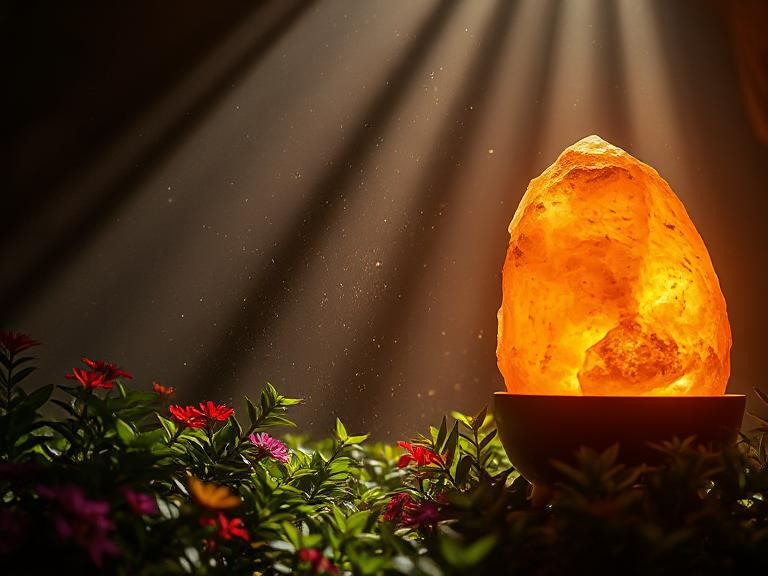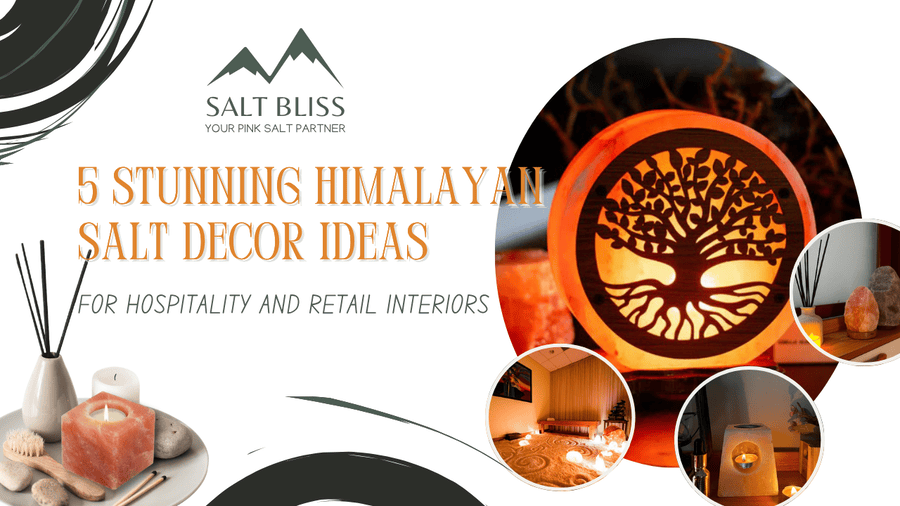Himalayan salt lamps, with their characteristic warm pink light and distinctive visual beauty, have fascinated home decor enthusiasts and health seekers as much as anyone else. Their popularity has fueled arguments over whether such lamps have any health benefits. Advocates say they purify the air, boost mood, and even enhance respiratory function, while skeptics dispute the science behind such assertions. In this article, we take a close look at the science behind Himalayan salt lamps, dispel popular myths, and discuss why SaltBliss is the exception to this crowded category.
What Are Himalayan Salt Lamps?
Himalayan salt lamps are cut from big chunks of pink rock salt, most of which is sourced from the Khewra Salt Mine in Pakistan—a place that is famous for its geological history and natural mineral wealth. The lamps are made up of a naturally shaped salt crystal shell with an interior cavity that contains a light bulb or a heating device. Once switched on, the lamp emits a warm, amber light that many users report to be soothing and relaxing.
Historical and Cultural Context
For centuries, salt has been prized not just for its application in food but for its so-called healing properties as well. Historical cultures throughout Asia and the Middle East have believed in the medicinal value of salt and applied it to rituals and traditional medicine. Today’s Himalayan salt lamps are a continuation of this rich history. While modern users may not fully subscribe to traditional beliefs, the lamps continue to evoke an air of mystique and himalayan wellness that appeals to contemporary lifestyles.
Composition and Natural Properties
The vibrant pink color of these lamps is the result of trace minerals such as magnesium, potassium, and calcium in the salt. While these minerals are a factor in the color and general beauty of the lamp, their levels are too low to provide the nutritional values sometimes attributed to them. Rather, these minerals are a natural indicator of the source of the salt and play a part in its overall individuality.
The Claims: Himalayan Salt Lamps’ Promised Benefits
A wide variety of wellness claims has surrounded Himalayan salt lamps that have circulated through the web and in retail areas. Whereas a few such claims have origins that rest in plain scientific reality, others try too hard. The main reported benefits and their associated science (or absence of the same) follow here.
1. Air Purification
Perhaps the most universal argument is that Himalayan salt lamps are air purifiers naturally. This was grounded on the fact that Himalayan salt, by virtue of being hygroscopic, captures water molecules. The belief holds that as humidity is attracted onto the surface of the lamp, with it dust particles, allergens, and toxins deposit on the surface of the salt, thereby cleansing the air.
Scientific Perspective
- Hygroscopic Limitations: Although salt does pick up moisture from the air, the action is not continuous enough to hold airborne impurities. When the salt is saturated, it no longer has the ability to absorb until the water evaporates.
- Air Cleaning vs. Air Purifying: Proper air purification generally involves systems such as HEPA filters, which are designed to remove particulate matter. The ability of the salt lamp to remove pollutants is limited.
- Temporary Effects: Any water molecules or particles that stick to the lamp will at some point return to the air, eliminating long-term air purification advantages.
2. Negative Ion Generation
Himalayan salt lamps are marketed by some producers for their ability to create negative ions. Negative ions are molecules that contain an excess electron and are said to provide a number of health benefits, including lowering stress levels, elevating mood, and improving respiratory health by opposing the positive ions created by electrical appliances.
Scientific Perspective
- Production of Ions in Nature: Negative ions abound in natural surroundings like near waterfalls or thunderstorm weather, and research has determined that these kinds of environments may have uplifting mood effects.
- Temperature Needs: For extensive ionization to take place, temperatures far in excess of those heated by a small lamp’s bulb (which will only reach a few dozen degrees Celsius at most) are needed. The best conditions for creating negative ions from salt are temperatures of almost 816°C—far more than a home salt lamp can produce.
- Practical Outcome: While the idea of negative ion production is scientifically sound, the reality of what comes out of a Himalayan salt lamp is too minor to make any perceivable contribution to indoor air quality or overall well-being.
3. Respiratory Health Benefits
Another widespread assertion is that the lamps can enhance respiratory function. This belief draws inspiration from the principles of halotherapy, or salt cave therapy, where breathing in salt-treated air is believed to ease respiratory conditions like asthma, allergies, and chronic bronchitis.
Scientific Perspective
- Halotherapy vs. Salt Lamps: In halotherapy, patients are in specially constructed salt rooms or caves where the air concentration of salt is controlled and much higher. Studies in this field have been promising for respiratory illnesses in controlled environments.
- Insufficient Exposure: Conversely, ambient release of salt particles from a lamp is negligible. The exposure is neither long nor dense enough to mimic the therapeutic effects that have been seen in genuine halotherapy.
- Clinical Evidence: Although halotherapy has been the subject of some clinical trials, the evidence does not exist to support the idea that having a Himalayan salt lamp in your living area will benefit your respiratory health.
4. Mood Enhancement and Sleep Aid
Numerous users attest that the soft, warm light of a Himalayan salt lamp establishes a calming environment, which can aid in the reduction of stress and allowing for improved sleep. The relaxing effect of soft, amber light is frequently likened to sunset’s effect, said to naturally promote relaxation.
Scientific Perspective
- Psychological Effect: The psychological effects of ambiance lighting are widely known. Warm, gentle light can slow down the production of melatonin-disrupting blue light, thus promoting a natural sleep pattern.
- Indirect Effects: Although the lamp itself does not have a direct effect on sleep structure by ionization or air purification, its contribution to the comfort and relaxing environment can benefit mood and sleep quality indirectly.
- Overall Ambiance: The major benefit of these lamps is their capacity to change the ambiance of a room, making it more relaxing, meditative, and relaxing after a tiring day.
The Myths: Busting Common Misconceptions
Even though Himalayan salt lamps are widely used, there are some myths that have been doing the rounds about their so-called health benefits. Here, we bust some of the most common myths.
Myth 1: They Dramatically Enhance Air Quality
Although it is a fact that salt has the ability to attract water molecules, the level of air cleaning done is negligible in comparison to what dedicated air purifiers can do. The concept that a salt lamp can clean pollutants on a mass scale is not backed by scientific evidence.
Myth 2: They Neutralize Electro-Smog
Electromagnetic fields (EMF) created by electronic equipment are commonly referred to as a contemporary health risk. Himalayan salt lamps are said to counteract or neutralize EMFs by some of their proponents. Nevertheless, there is no valid scientific evidence that establishes any EMF-protective effects of Himalayan salt lamps. Any impact on ambient electromagnetic radiation is basically non-existent.
Myth 3: They Create Therapeutic Levels of Negative Ions
The idea that heat from the lamp can generate enough negative ions to affect health is a misconception. As previously pointed out, temperatures needed for serious ionization are well above the levels these lamps can attain. Thus, the negative ions created are too negligible to provide tangible benefits.
How to Use and Care for Your Himalayan Salt Lamp
In order to get the most out of the aesthetic and ambient effects of your Himalayan salt lamp, correct use and care are important.
Usage Tips
- Placement: Place your lamp in the room where you’ll be spending the most time, like the living room, bedroom, or meditation room. Its gentle light may assist in making the atmosphere calming.
- Ambiance: Apply the lamp in the evening to aid your body in transitioning into the relaxed state necessary for a good night’s sleep. The soft, warm light can be a natural signal for unwinding.
- Decor Integration: Himalayan salt lamps blend well with organic décor styles, complementing other natural elements such as wood and stone.
Maintenance Guidelines
- Regular Cleaning: With time, the surface of your lamp might accumulate dust and moisture. Carefully clean the lamp using a dry soft cloth to wipe out dust. If moisture has settled in, a light touch with a damp cloth and an immediate drying will keep it looking intact.
- Avoid Excessive Moisture: Being hygroscopic in nature, salt tends to absorb moisture. Do not place your lamp in extremely humid spaces or near open water points to avoid early deterioration.
- Safe Use: Always adhere to the manufacturer’s instructions on electrical safety. Make sure the lamp is used with the recommended wattage of bulb and plugged into an outlet appropriate for it.
Market Trends and Insights
The worldwide market for Himalayan salt items has been witnessing strong growth over the last few years. The market size in 2023 was about $470.2 million and is anticipated to develop at a compound annual growth rate (CAGR) of 5.7% by 2030. This development is due to growing consumer interest in natural well-being products and unique home design.
Consumer Demographics
- Wellness Enthusiasts: A lot of shoppers are attracted to the concept of natural healing and look for products that ensure overall wellness.
- Interior Designers: The lamps’ exclusive, cozy light makes them desirable among interior designers who consider both function and appearance.
- Gift Buyers: Their unique look and perceived health benefits have resulted in Himalayan salt lamps being a popular gift item during holidays and special events.
Why Choose SaltBliss?
At SaltBliss, we are passionate about providing top-quality Himalayan salt lamps that not only beautify your surroundings but also evoke a feeling of natural well-being. Our commitment to quality and customer satisfaction distinguishes us in a number of important ways:
Authenticity and Quality
- Original Materials: Our lamps are made from 100% genuine Himalayan rock salt, which is ethically mined from the world-famous Khewra mines.
- Expert Craftsmanship: Each lamp is hand-carved by expert craftsmen, so that each lamp is really one-of-a-kind.
- Safety and Durability
- Built to Last: We employ long-lasting bases and trustworthy electrical parts to ensure that your lamp is safe and durable.
- Attention to Detail: From the smooth finish to the precisely embedded light source, every aspect is carefully crafted for your safety and comfort.
Enhancing Your Ambiance
- Relaxation Focus: Our lamps are crafted to produce peaceful settings perfect for meditation, relaxation, or simply relaxing after a long day.
- Positive Customer Feedback: Supported by outstanding reviews and a dedication to customer happiness, SaltBliss is relied on by users all over the globe.
Final Thoughts
Himalayan salt lamps are not mere decorations; they are an offer to add a sense of peace and nature to your daily space. Though some of the claimed health benefits—such as considerable air cleaning, negative ion emission, or EMF neutralization—do not have concrete scientific evidence to support them, these lamps have a certain worth that they provide a soothing atmosphere to increase general well-being.
Instead of just basing it on unsubstantiated health advantages, appreciate your Himalayan salt lamp as an exercise in beauty, the addition to a relaxing environment, and the subtle reminder of natural beauty. Using it as the centerpiece in your living room, a bed lamp to transition into sleep, or a distinctive accent in your workplace, these lamps are a subtle yet powerful addition to your space.
For those looking to blend style with well-being, selecting a high-quality, authentic product is a must. SaltBliss is committed to providing top-quality Himalayan salt lamps that meet both tradition and contemporary safety standards. Browse our selection and bring a touch of natural tranquility to your space.








